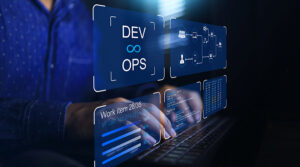DevOps is a design methodology that emphasizes continuous improvement, fast delivery, and cost optimization by recommending a set of engineering best practices to be implemented in IT environments. DevOps also emphasizes automation, which improves efficiency and engineering velocity during software delivery. It focuses on team empowerment, collaboration, communication, technology automation, and a work culture emphasizing continuous improvement and team collaboration, streamlining the software development process.
DevOps’s ultimate goal is to improve the workflow between software developers and IT operation staff. Consequently, the process requires monitoring to keep track of the applications and infrastructure in real time. That’s why we need DevOps monitoring tools.
This article spotlights monitoring tools in DevOps, their importance, different types, and what criteria you should choose when selecting the right tools for your organization. It also shares an online DevOps bootcamp for professionals who want to boost their skills.
First, let’s get acquainted with what the tools do.
What is DevOps Monitoring?
DevOps monitoring involves continuously identifying, analyzing, tracking, and reporting an IT infrastructure’s specific components. Engineers also call DevOps monitoring Continuous Monitoring (CM) or Continuous Control Monitoring (CCM).
The DevOps process follows a continuous pipeline of planning, developing, integrating, testing, launching, and operating phases. Although practicing DevOps can be quite an involved process, the benefits are worth the effort. Benefits of DevOps monitoring include:
- Define, track, and measure the key performance indicators (KPIs) across every aspect of DevOps
- Quickly detect and report anomalies to the relevant right so they can resolve the problems before they affect users.
- Increase observability of various DevOps stack components so users can spot when they degrade in performance, security, and costs, among other aspects
- Create a continuous feedback loop that enhances collaboration among everyone in the organization
- Using a range of tools to respond to threats on-call or automatically
- Locate automation opportunities throughout the DevOps process that can improve engineers’ DevOps efficiency and toolchains
- Identify future system behavior patterns that DevOps engineers should be on the lookout for
- Analyze logs and metrics to discover the root causes as soon as possible. Tracking logs and metrics helps pinpoint where issues began or occurred. Consequently, this improves the Mean Time to Detection (or MTTD), Mean Time to Isolate (MTTI for short), Mean Time to Repair (MTTR), and Mean Time to Recovery (also MTTR). Organizations can maintain optimal customer experiences by monitoring DevOps activities while reducing DevOps lifecycle costs.
Also Read: What is Docker Container? Steps to Use It and Its Benefits
Why is DevOps Monitoring Important?
Thanks to DevOps monitoring, teams can quickly and automatically react to changes in client experience. Additionally, it allows developers to shift left to earlier development phases, reducing the amount of broken production changes. With DevOps monitoring, issues can be detected and dealt with automatically or manually as needed, with better software instrumentation.
Different Types of Monitoring Tools in DevOps
DevOps monitoring takes many forms:
- DevOps application monitoring tools. These tools monitor application performances in real time, identifying performance bottlenecks with an application that measures its response over time. These tools help developers spot and repair bugs before the errors cause significant problems.
- DevOps continuous monitoring tools. There are two broad monitoring tool categories: tools that monitor live production systems (Nagios, Zabbix, Sensu, New Relic) and tools that watch a design before it’s deployed to production (New Relic Insights and Datadog).
- DevOps log monitoring tools. These tools monitor logs from different sources, such as applications, databases, servers, etc., and then analyze them for any errors or anomalies. This helps to quickly identify the root causes of any problems and fix them before they become significant issues.
- DevOps pipeline monitoring tools. Larger organizations use DevOps pipeline monitoring tools for better efficiency and productivity. On the other hand, smaller organizations typically don’t need these tools because they have fewer resources or employees than larger companies.
- DevOps server monitoring tools. DevOps log monitoring tools monitor logs from applications, servers, and other sources to identify errors or problems. This process helps identify server problems like OS crashes or hardware failures that may result in downtime for applications running on them.
Also Read: What is Site Reliability Engineering, and What Is its Role In DevOps?
Top Eight Monitoring Tools in DevOps
Here’s a sampling of eight outstanding monitoring tools in DevOps.
Nagios. Nagios monitors networks, servers, and IT systems. DevOps teams depend on its alerting tools to share notifications when infrastructures or applications run into errors. These alerts are reliable because they can track any device with an IP address.
- Features:
- Set up services that ping an organization’s devices
- Comprehensive documentation
- Custom plug-in development that matches requirements and checks the most critical production environment requirements
- Pros:
- Has a large, active user community
- Rich reporting features
- Easy to configure
- Cons:
- Has a steeper learning curve relative to similar tools
- Requires potentially significant configuration and maintenance, which can be complex and time-consuming
- Pricing:
- Open source, although there are pricing plans available for other Nagios applications
Splunk. Splunk uses an easy-to-use web interface to monitor machine-generated data. Its tools continuously track data at every stage of the app’s lifecycle, placing it in a central index for in-depth analysis. Splunk is ideal for teams that want to dive deeper into an application’s problems.
- Features:
- Delivers end-to-end visibility
- Supports many technologies like AWS, GCP, Azure, and Kubernetes
- Pros:
- Extensive community resources for learning and troubleshooting
- Reports are accurate down to the decimal point
- Spontaneously verifies unusual changes in data
- Cons:
- Dashboards are less interactive than other visualization tools
- The alerting system is less rich than similar monitoring tools
- Pricing:
- Includes free trial and multi-level pricing models.
Kibana. Kibana is a popular open-source data visualization and exploration resource best suited for log and time-series data. It offers an easy-to-use and navigate web-based interface, making it easily accessible.
- Features:
- Easy to use and navigate web-based interface
- Quick, uncomplicated setup procedure
- Provides an auto-highlighting function in the search fields to identify problems in log files quickly
- Pros:
- Includes powerful querying capabilities, such as filtering and aggregating data
- Allows users to create custom visualizations (e.g., lines, bars, and pie charts)
- Cons:
- Limited alerting capabilities
- Setup and configuration may be complex and time-consuming
- Pricing:
- Includes a free trial and monthly plans range from $95 to $175
Also Read: Top 10 DevOps Certifications for Professional Growth
Prometheus. Prometheus is a popular open-source system monitoring toolkit built explicitly for DevOps monitoring. It’s recognized as a powerful end-to-end monitoring system with a convenient alert manager.
- Features:
- It’s easy to program new features and advancements
- Collects time series data
- Works on a single server node rather than distributed storage
- Pros:
- It can be integrated with related DevOps tools, like Grafana for visualization or Alertmanager for alerting
- Includes PromQL, a powerful query language that provides precise and flexible metrics queries
- Cons:
- It’s only a data collection and storage tool; it requires extra components to handle use cases such as alerting and visualization
- Doesn’t have built-in support for distributed storage, making large deployment scaling challenging
- Pricing:
- Open source
Sensu. Sensu is a robust open-source monitoring framework designed for cloud environments. Developers can use Sensu to track and measure the health of their apps, infrastructure, and business KPIs in the way they want.
- Features:
- Monitors mission-critical systems
- Includes health checks, logs, and custom metrics
- Collects, filters, and transforms monitoring events, sending them to the team’s designated database
- Pros:
- Free to use
- It can be customized to fulfill any organization’s needs
- Provides advanced alerting capabilities
- Cons:
- Setting up and configuring can be complex and time-consuming
- It has fewer pre-built integrations
- Pricing:
- Free up to 100 nodes; SMB and enterprise pricing available
Grafana. Grafana is a popular open-source analytics and interactive visualization platform that uses pluggable panel architecture to support data presentation methods. It is commonly used to visualize and analyze data from disparate sources.
- Features:
- Provides commercial support, although it’s open-source
- Allows dynamic client registration and de-registration
- Automates processes
- Pros:
- It offers an alerting feature that can be integrated with other alerting systems, such as Alertmanager
- Includes a user-friendly interface, allowing users to create, edit, and share dashboards easily
- Cons:
- The alerting system is less rich than similar monitoring tools such as Prometheus or Nagios
- It’s primarily a visualization tool, so it doesn’t contain built-in data collection or storage capabilities
- Pricing:
- Open source
AppDynamics. AppDynamics provides continuous cloud-based DevOps monitoring solutions in software-as-a-service and on-premise approaches, allowing customers to examine the whole stack performance that powers the services. DevOps teams can capture data from database transactions, applications, infrastructure components, end-user sessions, and other sources to maintain total visibility and quickly respond to performance issues.
- Features:
- Cloud infrastructure monitoring offers insights into network components, servers, and databases, providing information on usage, status, and flow between each part
- End-user monitoring uses real-time, synthetic, and Internet of Things (IoT) tracking on smartphones and browsers
- Business-oriented dashboards and features visualize and analyze relationships between performance and business-related data
- Pros:
- Offers precise environmental information
- Provides sophisticated language features like automated leak detection and JVM-based stack object instance tracking
- All connections between system components, business activities, environment aspects, and endpoint response times are visible
- Cons:
- Agent must be manually downloaded and initiated during installation. There’s no online installation and configuration function
- The free plan does not include some fundamental data (e.g., system CPU, memory, and network consumption)
- Pricing is considered complicated, costly, and opaque
- Pricing:
- There’s a 15-day free trial. Multiple pricing levels range from $6/month to $95/month per CPU core
Dynatrace. Dynatrace is a full-stack observability solution featuring a user-friendly interface that monitors DevOps-related resources such as cloud apps, infrastructure, and logs. Once deployed, this tool provides a single operating agent managed by the Dynatrace UI, making monitoring enjoyable and easy to use. It’s the smallest library that can run application processes without using more than 10MB of server memory.
- Features:
- Monitor actual and simulated users
- Diagnostic tools make memory dumps, exceptions, CPU analysis, and top database and web queries possible
- Integrates with Docker, Kubernetes, and OpenShift
- Pros:
- Intuitive, powerful top-to-bottom view of the entire stack
- Straightforward agent installation with user interface (UI) help for new users
- Monitor cloud services logs and apps with a sophisticated integration library
- Cons:
- The serverless offering is restricted compared to other serverless alternatives on the market
- Options may initially seem intimidating
- Business metrics analysis is somewhat restricted
- Pricing:
- Pricing is based on features; pricing information becomes available once you join
Also Read: What is DevOps Culture and How to Create an Effective One
What Factors Should You Consider When Choosing a DevOps Monitoring Tool?
Developers may find it challenging to pick the appropriate DevOps monitoring tools. This difficulty may stem from the need to be aware of critical factors when choosing the ideal tools.
Developers should ask what kind of data they want to collect and if they want to monitor server load, network traffic, or application performance. Answering these questions can help you choose the best DevOps monitoring tools for the organization. Consider these points when choosing DevOps monitoring tools:
- Consider aspects like functionality, pricing, user-friendliness, and support
- Look for full-stack, end-to-end observability. This feature eases continuous DevOps monitoring that will alter business outcomes
- Consider if the tool offers interoperability and integration between AIOPs, ITSM, and operational tools
- Find tools that seamlessly integrate with current DevOps tools and systems
- The tool should expedite remediation and troubleshooting
- Consider scalability and flexibility. Choose a monitoring tool that can effortlessly scale up or down, depending on your requirements
- Conduct a pilot project or establish a proof of concept before making a final decision; evaluate your choice to guarantee they accommodate your needs
DevOps Monitoring Best Practices
Once you find the right DevOps monitoring tool, you’ll want to get the most out of it. For best results, follow these best practices:
- Monitor continuously. Continuous tools track threats before they can affect users. DevOps continuous monitoring tools save money in the long run and protect your reputation by avoiding breaches and noncompliance penalties. This extra security is especially prominent in SecDevOps.
- Integrate the tech stack. Integrations allow you to sync different tools in real time, and the resulting integrated data provides a more robust picture of operations
- Look for debugging features. Debugging tools help developers find and address bugs immediately, ensuring errors are remedied sooner
- Prioritize end-to-end observability. Monitoring every production stage helps detect subtle issues
- Accelerate remediation and troubleshooting. DevOps monitoring doesn’t just notice issues; it provides the means to solve them. Troubleshooting acceleration gets things back to production quicker
- Prioritize scalability and flexibility. Tools should change as a business grows, and scalable tools evolve without switching out the tech stack.
Also Read: What is Chaos Engineering in DevOps?
Learn More About DevOps
If you’re curious about DevOps, consider this 36-week online post graduate program in DevOps. This intense boot camp bridges the gap between software development and operations, imparting hands-on skills via continuous deployment industry projects in DevOps tools such as Ansible, Docker, Kubernetes, Prometheus, and Terraform.
Glassdoor.com reports that DevOps engineers earn an average yearly salary of $106,586. Consider this informative boot camp to enhance your DevOps skills.
You might also like to read:
What is DevSecOps? Definition, Benefits, Best Practices
What is DevOps Automation? A Beginner’s Guide
Embracing Efficiency and Automation with GitOps: A Comprehensive Guide






